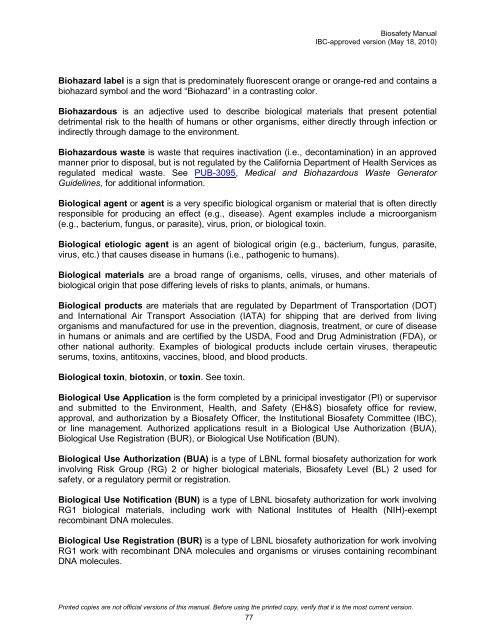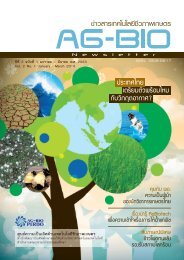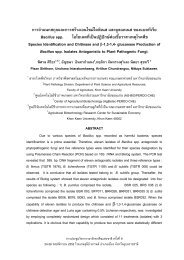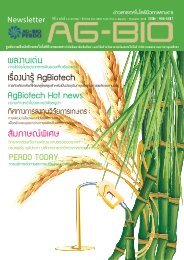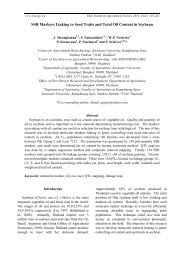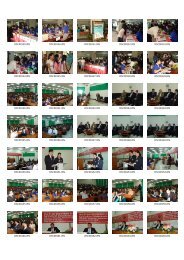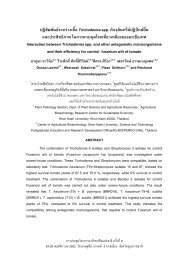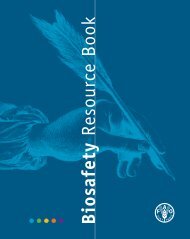Biosafety Manual PDF - Lawrence Berkeley National Laboratory
Biosafety Manual PDF - Lawrence Berkeley National Laboratory
Biosafety Manual PDF - Lawrence Berkeley National Laboratory
Create successful ePaper yourself
Turn your PDF publications into a flip-book with our unique Google optimized e-Paper software.
<strong>Biosafety</strong> <strong>Manual</strong><br />
IBC-approved version (May 18, 2010)<br />
Biohazard label is a sign that is predominately fluorescent orange or orange-red and contains a<br />
biohazard symbol and the word “Biohazard” in a contrasting color.<br />
Biohazardous is an adjective used to describe biological materials that present potential<br />
detrimental risk to the health of humans or other organisms, either directly through infection or<br />
indirectly through damage to the environment.<br />
Biohazardous waste is waste that requires inactivation (i.e., decontamination) in an approved<br />
manner prior to disposal, but is not regulated by the California Department of Health Services as<br />
regulated medical waste. See PUB-3095, Medical and Biohazardous Waste Generator<br />
Guidelines, for additional information.<br />
Biological agent or agent is a very specific biological organism or material that is often directly<br />
responsible for producing an effect (e.g., disease). Agent examples include a microorganism<br />
(e.g., bacterium, fungus, or parasite), virus, prion, or biological toxin.<br />
Biological etiologic agent is an agent of biological origin (e.g., bacterium, fungus, parasite,<br />
virus, etc.) that causes disease in humans (i.e., pathogenic to humans).<br />
Biological materials are a broad range of organisms, cells, viruses, and other materials of<br />
biological origin that pose differing levels of risks to plants, animals, or humans.<br />
Biological products are materials that are regulated by Department of Transportation (DOT)<br />
and International Air Transport Association (IATA) for shipping that are derived from living<br />
organisms and manufactured for use in the prevention, diagnosis, treatment, or cure of disease<br />
in humans or animals and are certified by the USDA, Food and Drug Administration (FDA), or<br />
other national authority. Examples of biological products include certain viruses, therapeutic<br />
serums, toxins, antitoxins, vaccines, blood, and blood products.<br />
Biological toxin, biotoxin, or toxin. See toxin.<br />
Biological Use Application is the form completed by a prinicipal investigator (PI) or supervisor<br />
and submitted to the Environment, Health, and Safety (EH&S) biosafety office for review,<br />
approval, and authorization by a <strong>Biosafety</strong> Officer, the Institutional <strong>Biosafety</strong> Committee (IBC),<br />
or line management. Authorized applications result in a Biological Use Authorization (BUA),<br />
Biological Use Registration (BUR), or Biological Use Notification (BUN).<br />
Biological Use Authorization (BUA) is a type of LBNL formal biosafety authorization for work<br />
involving Risk Group (RG) 2 or higher biological materials, <strong>Biosafety</strong> Level (BL) 2 used for<br />
safety, or a regulatory permit or registration.<br />
Biological Use Notification (BUN) is a type of LBNL biosafety authorization for work involving<br />
RG1 biological materials, including work with <strong>National</strong> Institutes of Health (NIH)-exempt<br />
recombinant DNA molecules.<br />
Biological Use Registration (BUR) is a type of LBNL biosafety authorization for work involving<br />
RG1 work with recombinant DNA molecules and organisms or viruses containing recombinant<br />
DNA molecules.<br />
Printed copies are not official versions of this manual. Before using the printed copy, verify that it is the most current version.<br />
77


